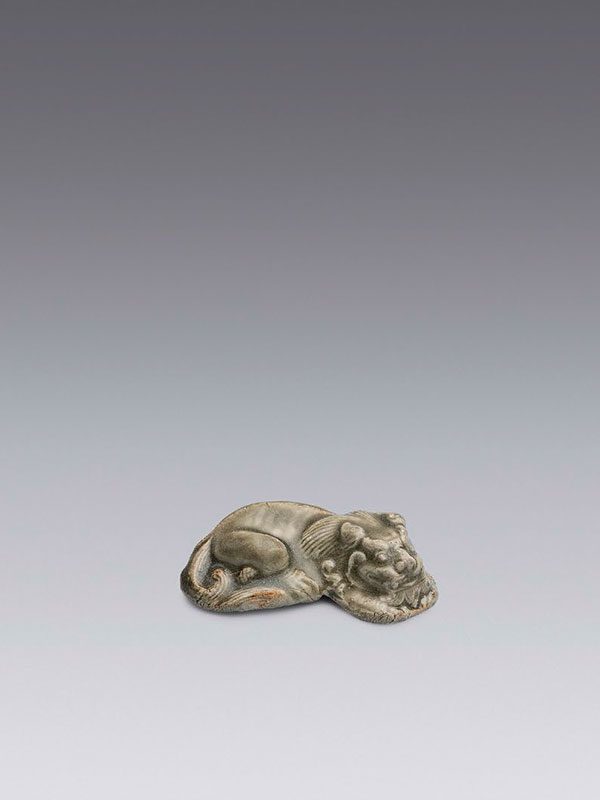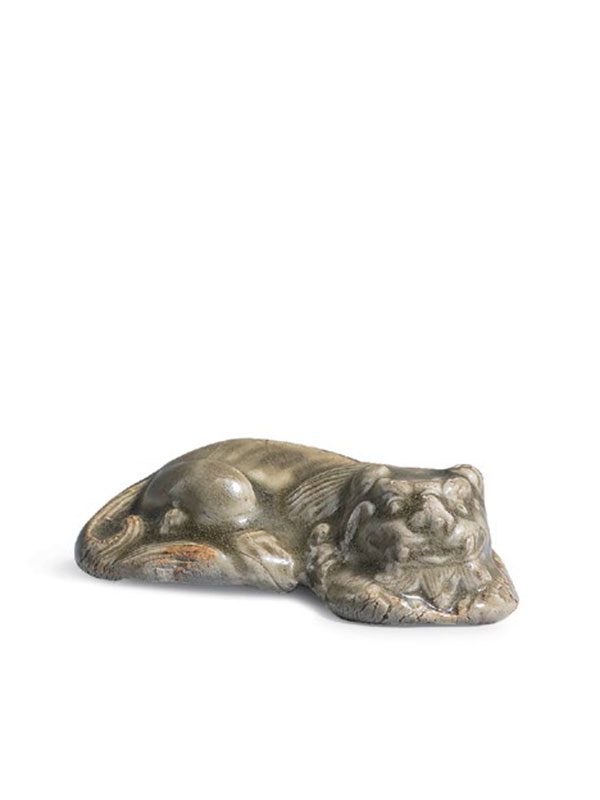Yaozhou stoneware model of a recumbent lion
A yaozhou stoneware model of a recumbent lion. The animal turns its head toward the right side of its body, with ears folded down, its four legs tucked under its body and paws resting flat on the ground. The round eyes, strong jaw, and curly mane are well defined. The tail is curled around the hindquarters. The surface is covered in a lustrous translucent olive-green glaze, which pools to a slightly darker colour in the recesses. The base is recessed and unglazed, showing the original buff body.
In China, lions were admired for their strength and courage, and were associated with military and hunting prowess. Lions (shi) were not indigenous to China, but were known in Iran and the Near East where they were associated with royalty. It was in India where they acquired religious meaning as temple guardians, and they were later known in China as ‘protectors of Buddhism’. Real lions were actually sent to China as tribute as early as 87 BC.1 Small ceramic lion models were produced earlier, such as a Tang dynasty (618 – 906) seated lion paperweight made in the Changsha kiln [2] or a Five Dynasties (907 – 960) example produced in the Yue kiln.[3] Lion figures produced in the Yaozhou kiln are extremely rare. Fragments of three comparable small lion figures and some oil lamps in the form of a recumbent lion were unearthed from the Yaozhou kiln site at Huangbaozhen, Tongchuan county, Shaanxi province.[4] A further comparable lion figure in the form of an incense burner top, dated to the Northern Song dynasty, is in the collection of the Cleveland Museum of Art.[5]
- Welch, P. B. Chinese Art- A Guide to Motifs and Visual Imagery, Tuttle Publishing, Singapore, 2012, p. 135
- The example was illustrated in Li, H. B, ed. The Complete Works of Chinese Ceramics, vol.6 – Tang and Five Dynasties, Shanghai People’s Publishing House, Shanghai, 2000, no. 19, p. 38
- This lion figure was unearthed from Zhejiang, and now is in the Zhejiang Provincial Museum. See Ho, Chuimei, New Light on Chinese Yue and Longquan Wares- Archaeological Ceramics Found in Eastern and Southern Asian, AD. 800- 1400, Centre of Asian Studies, the University of Hong Kong, 1994, pl.2-D, p. 19
- Institute of Archaeology, Shaanxi Province and Yaozhou Kilns Museum, The Yaozhou Kiln Site of the Song Period, Cultural Relics Publishing House, Beijing, 1998, pls. CXX 1-3,
- The Cleveland Museum of Art online collection archive, The Fanny Tewksbury King Collection 1966.26
耀州窯青釉瓷塑臥獅
宋至金 十二 – 十三世紀
長:7.5公分 寬:4 公分
瓷塑臥獅,獅身微曲,四肢平貼於地,獅首枕於前肢上,雙目張圓,鬃毛與長尾毛髮濃密。通體施
橄欖綠青釉,釉色透亮瑩潤,積釉處呈湖水綠。自古以來,獅子於伊朗與近東象徵皇權,並在印度
逐漸與宗教相連結,成為寺廟之守門獸。中國境內並無原生獅種,但最早已於西元87年經由朝貢傳
入中國,小型瓷塑獅則已於唐代長沙窯及五代越窯產出。耀州窯製作之獅型器屬稀少品類,數件小
型獅子塑與獅型燈盞曾於宋代耀州窯址發掘出土。美國克里夫蘭博物館則藏有一件耀州青瓷爐蓋,
以坐獅為蓋鈕,亦可為比較。


